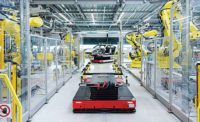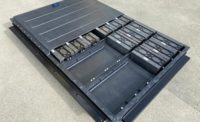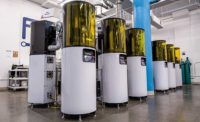Electric vehicles promise to transform the automotive landscape. But, don’t expect to see too many differences in assembly plants as automakers start ramping up production.
Ford Motor Co., General Motors Co. and Nissan Motor Co. plan to build electric vehicles on the same assembly lines as traditional internal combustion engine (ICE) vehicles. They’re taking a chapter from Toyota Motor Corp., which has built its popular Prius hybrid for more than a decade at its Tsutsumi plant in Toyota City, Japan. The extremely flexible facility also makes a wide variety of ICE vehicles, such as the Camry sedan.
Several weeks ago, GM started to assemble the Chevy Volt at its Detroit-Hamtramck plant. The Volt is assembled on the same line as the Cadillac DTS and Buick Lucerne.
“The manufacturing flexibility that General Motors has designed into the facility has allowed Volt production to be incorporated in-line with the larger sedans,” notes Chris Lee, manager of manufacturing and labor communications.
“The Volt is assembled in-line with the DTS and Lucerne and uses much of the same flexible equipment,” adds Lee. “[However], there are some unique operations in the Volt assembly process, [such as] the battery load, which is done from below in a similar manner to the traditional body-power train ‘marriage.’
“For the most part, aside from the propulsion system and the battery, the Volt is constructed just like any other contemporary car,” Lee points out. “Because of the battery and high-voltage lines, there has been additional employee training at [the plant] to ensure both safety and a quality product.”
Nissan also recently started to assemble its all-electric Leaf at its factory in Oppama, Japan. The vehicle is due to go on sale in the United States next month.
Unlike the Volt, the Leaf does not contain an internal combustion engine. It is powered by 48 lithium-ion battery modules. An 80-kilowatt electric motor drives the front wheels and generates maximum torque that’s equivalent to a traditional 3-liter, V6 engine. However, the Leaf is assembled beside popular gasoline-powered Nissan models such as the Cube and the Juke.
“Part of the assembly line has been modified to mount battery modules at the stage of production where fuel tanks are traditionally installed,” says Hidetoshi Imazu, executive vice president of manufacturing. “Motors and inverters are mounted at the point where engines are installed in gasoline-powered vehicles.”
Lithium-ion battery modules are manufactured at the Automotive Energy Supply Corp. operation in Zama, Japan, which is a joint-venture between Nissan and NEC Corp. The battery modules, which each contain four battery cells, are shipped to the Oppama facility, where they are assembled into the Leaf’s battery pack.
Nissan also plans to assemble the Leaf at its flexible plants in Smyrna, TN, and Sunderland, England. According to Imazu, Oppama will serve as the '”mother plant” for the production of the Leaf in other parts of the world. “We will use all of the know-how . . . from Oppama to ensure the highest quality at all sites that manufacture Nissan EVs,” he points out.
Ford plans to introduce five new electrified vehicles over the next two years. It plans to assemble hybrids, plug-in hybrids, and battery electric vehicles on the same production lines as conventional vehicles.
“No special equipment is needed,” claims Sherif Marakby, director of electrification programs and engineering. “In fact, we will be building the Focus electric on the same line as our regular Focus vehicle at the Michigan Assembly Plant. We want these vehicles to be similar in the way they drive, handle and work . . . regardless of whether you are using gas or electricity to fuel the vehicle.”
Never miss the latest news and trends driving the manufacturing industry
Stay in the know on the latest assembly trends.
JOIN TODAY!Copyright ©2024. All Rights Reserved BNP Media.
Design, CMS, Hosting & Web Development :: ePublishing



